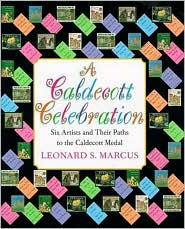
BIBLIOGRAPHY
Marcus, Leonard S. 1998. A COLDECOTT CELEBRATION: SIX ARTISTS AND THEIR PATHS TO THE CALDECOTT MEDAL. New York, NY: Walker and Company. ISBN 0827865861.
PLOT SUMMARY
To mark the 60th anniversary of the prestigious Cadlecott Medal author Leonard S. Marcus highlights six, one from each decade, illustrators and past winners. Through biographical information and anecdotes on creating their books, Marcus relays the stories of Robert McCloskey, Marcia Brown, Maurice Sendak, William Steig, Chris Van Allsburg, and David Wiesner of how they became and struggled as aspiring illustrators and award-winning illustrators.
CRITICAL ANALYSIS
A Caldecott Celebration is wonderfully formatted and well written for all ages to read and learn about this distinguished award and the story of the artists. Marcus introduces the man behind the award, Randolph Caldecott, explains how the award came to be as well as the process of how the committee decides on a winner. Each artist story begins with the title and picture of the award-winning book, which artistic medium was used to create the illustrations, and a personal quote from the illustrator’s acceptance speech.
The greatest element of this book is the stories of the illustrators discovering their love and the struggle of illustrating. Marcus provides instances of how illustrators researched to create realistic artwork. One wonderful example of how Robert McCloskey, for his book Make Way for Ducklings, lived with sixteen ducks in order to truly capture how they acted and how “the underside of the duck’s bill looked like when the duck was in flight”, and how the thinking and developing process is a rollercoaster ride much like how Maurice Sendak’s Where the Wild Things Are started out as a book about horses and was for a while marked as “ABANDON!!!” and as a “dreadful story!!” (Marcus 1998, 8, 21.) Best of all of the stories is the reactions upon hearing they were the winners. This truly shows the readers how with hard work good things can happen.
To compliment the stories of how the artists found their love of illustrating and how they were inspired to create their books, there are pictures of initial sketches and book dummies that gives the readers a wonderful glimpses of the physical processes of creating a picture book. Finally at the end, the book provides the list of all Caldecott Medal winners from 1938 to 1998 as well as a glossary of words used within the text, such as “art director,” “lithographic crayon,” and “white space.” These two final book elements allow the readers to continue looking at award-winning picture books and to explore world of the illustration process.
REVIEWS
THE HORN BOOK
"The text is remarkable for the smooth integration of explanatory material with overall commentary, and selective detail creates a sense of intimacy and understanding. The research never overpowers the narrative, but the reader knows that it is there--a firm footing for the structure it supports. A fresh, inviting examination of an established process and ritual." (v. 74 no. 6 (November/December 1998) p. 756.)
SCHOOL LIBRARY JOURNAL
"While the focus is on the creation of the award-winning book, a great deal of background about the artists' lives and the way in which they work is given. . . . With an index, a glossary (lithographic crayon, pre-separated art, etc.), and a bibliography of all of the Caldecott Medal winners (though not the Honor Books), this title has just about everything readers might want. Most of all, it has such wonderful tidbits--Robert McCloskey sketching the bottom of a duck's bill from his vantage point on the floor, Maurice Sendak buying an armful of roses for Ursula Nordstrom when he won, etc. So many good stories for children and adults to enjoy." (v. 44 no. 12 (December 1998) p. 140)
CONNECTIONS
* Read more books from the Caldecott Medal winners list: Noah’s Ark (Peter Speir), The Polar Express (Chris Van Allsburg), Saint George and the Dragon (Margaret Hodges), and much more!
* Do art projects using the same art mediums that the illustrators used for their books: gouache, crayon, watercolor, ink, tempera, and Conte crayons.
*Have the children create their own picture books with their own text and illustrations.
*Read other books pertaining to creating and illustrating picture books: such as the Talking with the Artist series by Pat Cummings.
No comments:
Post a Comment
Thank you for visiting, WP-CC! Please leave a comment!